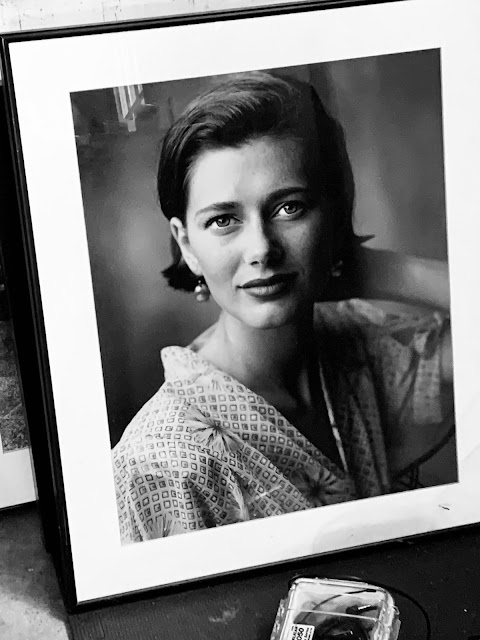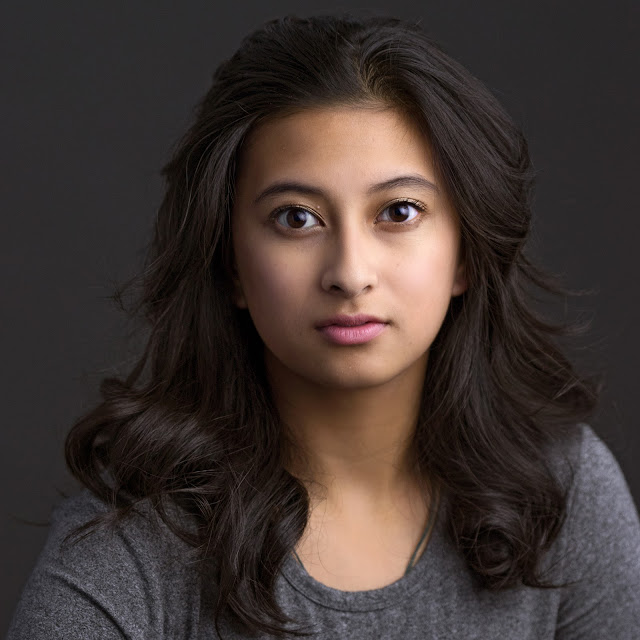Stand back as we open a potentially explosive can of worms. Let's talk about making black and white images with modern, color digital cameras. It's all in the wrist?
I don't have a constant, "go to" style that I'm relentlessly following as a photographer. Some days I like images with deeply saturated colors and other days I like ephemeral pastels. Some things just have to be in color while at other times I love the classic look of a black and white photograph. I guess my point is that I don't just have a "dog in the hunt", I have a whole pack of dogs and they're dragging me in all different directions. But I suppose that's what I have come to like about photography.
Case in point: Friday I tried my best to post a completely monochrome bit of blog. But that afternoon I walked by a shop and in the window was a mannequin dressed in bright red leather. I tried a black and white frame but everything just looked like gray mush. I shot it in a "vivid" color setting on the camera and loved the punch of the color. But on the same venture out I took a black and white portrait of "Casino" that I really liked. I'd say I'm positing an argument for flexibility but the reality is that I'm always a bit torn whichever side of the color versus monochrome fence I'm currently straddling.
In my early photo career we shot mostly black and white. It was a question of economics. Black and white film was much cheaper. Developing one's own film made economic sense at a point where there was always more time on hand than money. And printing black and white in a darkroom was magical. Part of the magic was that you could emerge from the red glow of the safelight lit darkroom with some thing tangible in your hands. Proof of your labor. A physical souvenir of your adventures with a camera...
In the early days of my work as a commercial photographer the world was transitioning from a black and white advertising eco-system to a full color workplace. My first feature photo for Texas Monthly Magazine was black and white. And everything after that was color. But the sentimentality of those carefree black and white days permanently colored my idea of what true photography was supposed to be all about. Even when that was no longer true.
Lately, with more time to spend on personal projects, I've leaned a bit harder into making photographs that start out and finish as black and white images. Almost all of them are destined for life on the web but some are good enough (for me) to also make the jump to black and white prints.
In the process of trying to emulate the black and white work I did with a number of different types of black and white films, across a handful of different cameras (pre-digital), I've learned a few things about how to best capture and process images taken with a color digital camera when my overriding intention is the creation of black and white images.
I'd like to share them here.
But first a quick discussion of how I like my black and whites to look....and styles of which I am not fond.
I hate flat, milky gray images. I want good blacks and crisp highlights and, if I can manage it I want elevated contrast in the mid-tones. I'm never trying to achieve "a long and virtuous" range of gray tones at the expense of contrast and implied acutance. I don't desperately try to hold on to the last vestiges of shadow detail in most images because, well, in most images it just isn't important. Some deep, details shadow can be visually comfortable.
When I make portraits in black and white I want flesh tones to be believable. There's tendency today by photographers to make skin tones as crunchy and contrasty as hell. Almost as if a legion of shooters got their "clarity" slider stuck at 200%. And dark. Everyone is processing their already crunchy skin tones very darkly. Maybe it's an attempt to keep whatever highlights are left from blowing out as a result of the breathtaking overall contrast....
I dislike black and white landscape photographs with bald, detail-less skies.
What I like is a sense of tonal balance with judicious addition of snappy midrange contrast. I want something in the frame, somewhere to go black. Not dark with detail. Just Moriyama Black.
You've probably seen enough of my black and white work to understand what I mean so let's move on to how I try to get there.
I've toyed with the idea of getting a monochrom Leica Q2 or even a Leica M Monochrom but I just can't go there. The idea of being landlocked away from color if I want it is just too great for me. And to spend $6K+ for a specialty rig is more than my middle class upbringing can stomach. I've borrowed monochrom cameras from time to time; when wealthier friends are willing to indulge me, and I find them too constrictive. I want more wiggle room for my vision of how black and white should be. And, to complicate things, my vision changes from time to time. What works in one season seems like a roadblock to seeing in another.
I've decided that it's best for me to explore the cameras I like to shoot with and experiment towards making black and whites that make me happy with those particular cameras.
Here's my basic formula, arrived at by compensation for the Leica SL's (the 2015 model 601) very, very limited menu of file adjustments: I go into the Jpeg settings and I am confronted with controls that don't allow fine-tuned adjustment. No "baby steps" just big, lumbering jumps. I have the following things I can work with: Contrast. Sharpness. Saturation. Noise. That's it. Unlike my (now departed) Fuji X100V cameras there is not an endless array of micro adjustable choices with which to fine tune. Just those four parameters.
I start with the most important step which is to make the files monochrom which is one of the settings in saturation settings. My second step, regardless of the shooting conditions or subjects, is to set the contrast to medium high. Medium high is the ONLY choice between the middle setting (normal) and "High" contrast. I'm afraid of going too high with the contrast because I am mostly shooting Jpegs and if I trip over the line and over-charge the image with contrast it's hard to come back from.
My next step is to turn up the sharpening which has the effect of actually introducing more acutance to the image and does bump up contrast a bit in the mid-tones. Sharpness also gets the "Medium High" setting. Any higher and I start to get the dreaded halos... No one wants the dreaded halos.
Finally I turn the noise reduction down to low. That's as low as it will go. If there was an "off" setting I'd gladly try that because grain/noise doesn't affect my particular vision of black and white imagery. In fact, for the most part, the more grain the better.
These settings are a good starting point for me with my two absolute favorite cameras. When I pull a file into Lightroom, which is my preferred post process application, I go a little deeper and nearly always add more mid-range contrast via the clarity slider. I don't make pixie moves with the slider. No 4s or 5s. I start at +25 and go up from there. If the image is highly detailed I also lean on the texture slider but I'm a bit more judicious there and rarely go higher than +12 or +15.
Finally, if the blacks are too weak (not usually an issue) I tweak the "Dehaze" control and add just enough to make the deep tones deeper and richer.
This all seems to work for me. You'll need to adjust to taste. And this is where I go when I'm using the older Leica camera models. Mostly because their range of adjustments is quite limited and the controls are so coarse.
In the CL and SL2 models there are a few more options. The biggest one being the addition of a profile called Monochrom HC. The "HC" of course standing for high contrast. But I still find myself adding contrast in the profile menu. With those two cameras I also find that using the shadow and highlight sliders in post can help me get nicer flesh tones without destroying the overall contrast I work at getting in a picture.
I'm not into subtle moves with sliders in Lightroom. I'll jack the shadow slider to +50 or +60 and the highlight slider to "minus the same amount.." There is one last slider that I use to add pop to an image and that's the white slider. Not white balance but just "white." If an image looks too mushy and too gray in flesh tones or on a main subject I increase the white slider and it adds some pop without destroying to the top of the curve which is being tamed by the highlight slider.
In some images, if the nature of the subject evokes a 1960's, 1970's feeling, I'll add some grain to the overall image. But lately I've just depended on using higher and higher ISOs to add overall noise to a file. Kind of a mini-rebellion against overly "clean" images. Again, I'm sure it's a sentimental throwback to my old style of film era black and white were even ISO 400 films, developed in Rodinal, had obvious grain when printed large.
Since I'm mostly shooting in Jpeg for myself I try to get as much done as I can in the camera and not depend too much on "saving" images in post. If I screwed up while shooting I toss the file in the trash rather than try spending hours rescuing what, many times, turns out to be a boring image anyway.
In my own way, by shooting black and white Jpegs I am cutting off any path to surrender to color after the fact. So, in that sense I get what Michael Johnston is saying about banishing the choice. Being fickle I might want to see color later. If that happens my only recourse is to saddle up and head back to reshoot but with the camera set up for color. It's relatively rare for me to shoot something in color and then want to make a black and white image from the file. My brain isn't really wired to go in reverse like that.
Every camera is different and requires its own formula for your kind of black and white. But I would suggest that a good starting point is always to bring back the pop we used to get printing a juicy negative on grade three paper by adding contrast. And especially contrast in the mid-tones. That's where it makes the difference.
Shooting in Raw and then deciding on a direction is too safe. A compromise between the fear of losing the potential of a file and not having a clear enough vision while actually pushing the shutter to make a choice. But that's just the way my brain works...
















.jpg)


.jpg)













.jpg)






















.jpg)















-2.jpg)














.jpg)







